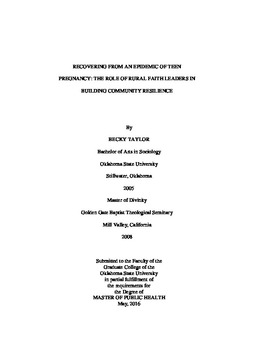| dc.contributor.advisor | Croff, Julie | |
| dc.contributor.author | Taylor, Rebecca Ann | |
| dc.date.accessioned | 2017-02-22T22:16:33Z | |
| dc.date.available | 2017-02-22T22:16:33Z | |
| dc.date.issued | 2016-07-01 | |
| dc.identifier.uri | https://hdl.handle.net/11244/49166 | |
| dc.description.abstract | Oklahoma has the 3rd highest teen birth rate in the nation. High rates of teen pregnancy within a community represent a burden that mirrors a disaster. A community�s level of vulnerability, resilience, and adaptive capacity determines whether the community is able to respond and recover and return to a state of pre-event functioning according to Disaster Resilience of Place (DROP) model. Faith leaders are uniquely qualified to address the juxtaposition between faith and health, thereby increasing community resilience in rural communities.This study utilized a qualitative research design of faith-leaders residing in two rural communities. In-depth interviews used a deductive approach with a semi-structured interview guide to explore the role of faith-leaders and congregations in teen pregnancy prevention. A grounded theory approach was used for analysis of interview transcripts. Sixteen faith leaders from Evangelical and Non-Evangelical Christian faiths, and Judaism were interviewed in two rural communities matched on size. The names of these towns have been altered for confidentiality. Interviews from Tonka suggest that it is less resilient and more vulnerable. Predictors of community resilience include partnerships across denominational lines, and theological interpretations that prioritize body, which tend to be held by Non-Evangelical faith leaders. Tonka has among the highest teen pregnancy rate in Oklahoma and far exceeds the teen pregnancy rate of Tolula. The stronger partnerships across denominational lines to meet community needs in Tolula makes Tolula a more resilient community than Tonka. Population health will be improved and teen pregnancy rates reduced when faith-based organizations�despite theological differences�partner and utilize its resources in a way that benefits the community at large. | |
| dc.format | application/pdf | |
| dc.language | en_US | |
| dc.rights | Copyright is held by the author who has granted the Oklahoma State University Library the non-exclusive right to share this material in its institutional repository. Contact Digital Library Services at lib-dls@okstate.edu or 405-744-9161 for the permission policy on the use, reproduction or distribution of this material. | |
| dc.title | Effects of Extended Water Restriction on the Hematological Cell Distribution of Beef Cattle in Confinement | |
| dc.contributor.committeeMember | Hubach, Randolph D | |
| dc.contributor.committeeMember | Story, Chandra | |
| osu.filename | Taylor_okstate_0664M_14492.pdf | |
| osu.accesstype | Open Access | |
| dc.description.department | Public Health (MPH) | |
| dc.type.genre | Thesis | |
| dc.type.material | text | |
